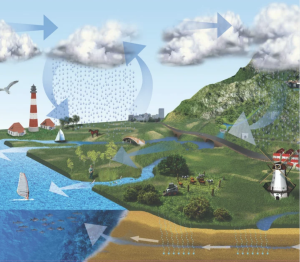Stormwater runoff is one of the biggest threats to Florida’s natural waterways and water quality. Runoff refers to water from everyday rain events, which happen frequently during our summer months. Contaminants such as fertilizer, animal waste, pesticides, oil or gasoline from parked cars mingle with rainwater, swirl into a toxic tea, and are carried into our rivers, ponds, and oceans. For years stormwater ponds have been presumed to be sufficient to capture and treat runoff- with over 76,000 across the state, they are a staple of the Florida landscape. However, studies have shown that ponds do not typically remove the 80% they are credited, closer to 45% for pollutants like Nitrogen. The problem is such a concern that starting next year, new stormwater rules will require greater treatment of runoff, through use of practices like Green Stormwater Infrastructure.
SAVE IT ON A RAINY DAY
That’s where Agricultural and Biological Engineering’s Eban Bean, Ph.D., steps in. He works with a team of engineers, researchers and environmental experts to minimize the effects of stormwater runoff through Green Stormwater Infrastructure protocols. These strategies look at capturing and filtering contaminant carrying runoff before it reaches vulnerable waterways and eventually our aquifer. Their work is supported in part by a one-million-dollar grant with UF IFAS’s Nature Coast Biological Stations from the National Academy of Sciences, and this past July they partnered with the Center for Watershed Protection and collaborators across the SE US to receive one of only four Stormwater Center of Excellence grants from the US Environmental Protection Agency.
Especially prevalent in highly urbanized areas with vast expanses of concrete and asphalt, stormwater runoff occurs in places where water does not have an opportunity to absorb back into the ground. Green Stormwater measures tackle these issues through infrastructural planning, strategic plant placements, and retrofitting existing structures to reroute stormwater.
RAINY DAY HEROES
Bean clarifies, “When you go from a natural landscape to an urban landscape and you look at how rainwater flows, in a natural environment a lot of that water ends up going into the ground. Roots of plants take it up, maybe only 10% becomes runoff. When we increase imperviousness, as places become more developed in built environments, much more of the water becomes runoff.”
Green Stormwater Infrastructure use strategies to retain, filter and store stormwater before it flows into our natural waterways, disrupting the balance of vulnerable aquatic life. It’s a multipronged approach; initial infrastructural changes such as swales along a sidewalk, tree boxes along a roadway, permeable pavements in parking lots, installing green roofs on buildings , strategic placements of plants, and retrofitting existing structures can all make an enormous impact.
“When water runs off your rooftop, it typically goes into the gutter, it runs off the driveway, into the street, into a storm drain that flows into a stormwater pond; there’s never a place for that water to absorb into the ground before entering a pond and eventually flowing downstream. One of the impacts of Green Stormwater Infrastructure is to disconnect that imperviousness and provide opportunities for that water to go into the ground, or at least treat the water more effectively along its path,” Bean explains.
PURPOSEFUL PLANTING AND INTENTIONAL INFRASTRUCTURE
“For rain gardens and stormwater ponds there are large and small trees, shrubs, and grasses that are native and can handle both drought and saturation during the months when it rains every day. As we know, in Florida, we may go for an entire month or more without rain, and then it rains daily,” he continues. Strategic planting can reduce erosion and soak up rainwater by the roots, but also some plants are especially useful for filtering contaminants. Dr. Bean feels strongly about his work in water; “I want to help the people of Florida protect their water resources, to protect the Florida that has been here for so long. It’s a passion of mine to help. It’s always a good time to implement some green infrastructure!”
 0
0

